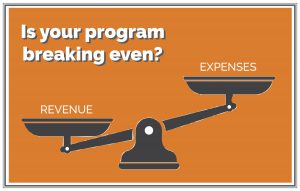For early childhood education programs and other nonprofits, knowing the organization’s “breakeven point ” is crucial. This is where expenses and revenue break even, meaning you have enough funding to run your program.

Operating a high-quality early childhood education program is expensive. In 2017, Child Care Aware of America produced a report called Parents and the High Cost of Care. This report discusses the aspects of high-quality programs that drive up the cost and acknowledges the gap between the cost of operating a program and the amount that families can afford to pay.
Often, program administrators cannot pass that entire expense on to families of young children because most families cannot afford the full cost. Child Care Aware of America finds that nationally, on average, married couples spend 10% of their income on childcare for one child, while single parents spend 36%. Therefore, many programs end up stitching together various funding streams to reach their breakeven point.
At Transform Consulting Group, we’ve partnered with Early Learning Indiana on a project designed to improve the financial stability and sustainability of early childhood education programs. We’re currently working with 10 programs in Indiana to help them access new funding streams and accomplish their financial goals.
For many programs, the financial goal was to improve their internal systems, procedures, and accounting practices. They did not know exactly how much they needed to bring in weekly, monthly, or annually to meet their financial obligations, let alone make any changes, such as increasing staff wages, expanding to serve more children, or implementing a scholarship or tuition assistance program.
For this project, we adapted a tool developed by First Children’s Finance that helps programs determine their breakeven point. This tool enables programs to decide on their overall program expenses and revenue. It also calculates the number of children they need to enroll in each classroom for each room to break even. If your program doesn’t already calculate its breakeven points, there are many reasons to start now!
Why Calculate Your Breakeven Point?
Calculating your breakeven point for your overall program and each classroom tells you whether or not your current revenue levels genuinely cover all your expenses. Many early childhood education programs know that the tuition parents can afford does not cover their costs, but they may not know their actual deficit. Other programs know their overall annual surplus or deficit but don’t know how much revenue they need to break even in each classroom.
For example, it is more expensive to operate infant classrooms than preschool classrooms. If you calculate your breakeven points, you may learn that enrolling your preschool rooms at 90% of their capacity will cover the deficit in your infant rooms. Infant care is a significant need in most communities, and therefore, it is likely an essential part of the mission of an early childhood education program. Because of this, programs accept that they will have a deficit in those rooms, but now they can move forward with a plan to recoup their losses.
As in the example above, other types of nonprofits also need to be aware of their overall breakeven point and the breakeven points of their various programs. An after-school organization might run an arts program, a sports program, and an academic enrichment program. The after-school leadership team may learn that the arts program isn’t currently breaking even, but scaling up the program would help the bottom line.
When Should You Calculate Your Breakeven Point?
Some organizations may use a breakeven tool annually, updating it to provide a check on how they are budgeting. Another use of a breakeven tool is when an organization is considering a change like one of the following:
- Moving to a different location with different space constraints
- Expanding one or more existing programs
- Adding a new program
- Anticipating the loss of a particular funding source
One of the ten early childhood education programs we worked with during this project was Mt. Pleasant Child Development Center. They were excited to use the breakeven tool to check how each of their classrooms’ breakeven points factored into their budget. They also wanted to use the information gleaned from the tool to determine how much funding they could reinvest in their staff benefits.
At TCG, we understand that performing this financial assessment can be difficult and time-consuming. If your program needs support evaluating your current budget or help with achieving your future goals, contact us today!

